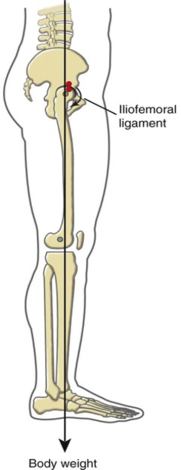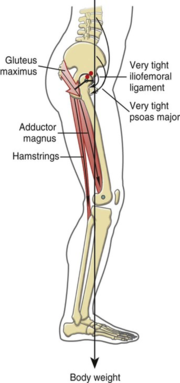Principles of Biomechanics in Hip Flexion Contracture
Original Editor - Ayesha Arabi
Top Contributors - Ayesha Arabi, Shreya Pavaskar and Kim Jackson
Introduction[edit | edit source]
A flexion contraction is a flexed joint that cannot be straightened actively or passively (NCBI, 2020). It is therefore a chronic loss of joint motion as a result of structural changes in the muscle, tendon, ligaments.
In the case of hip flexion contracture, hips that remain flexed for a long period of time are more likely to develop flexion contracture. Bilateral hip flexion contracture is common and considered an occupational hazard of students, office workers, and those who spend most of time in a seated position.
This condition may also be associated with weakness of hip extensors, spasticity of the hip flexors or an inflamed hip joint capsule. Consequently,
shortening of the hip flexor muscles and capsular ligament is observed. Hip flexion contracture leads to a disturbance in the normal biomechanics resulting in metabolic inefficiency of upright standing and gait.
Normal Posture Biomechanics[edit | edit source]
In a healthy individual, standing is maintained with relatively less muscular activation around the hip. The capsular ligaments play a crucial role as it passively stretches to oppose the body weight torque force resulting in the passive stabilization of the extended hip joint.
Furthermore, in an ideal standing posture where the hips are in near full extension, the force of the body weight directs slightly posterior to the axis of rotation at the hip. This force, when posterior to the axis, will generate a small yet useful hip extension torque.
Further extension is however impeded by the stretched capsular ligament and hip flexor muscles by creating a passive flexion torque. This static equilibrium formed between the body weight and the stretched tissues reduces the need of metabolically muscle activation during normal standing posture.
In addition, upright ideal standing posture favors the alignment of acetabulum and femoral head in a way where each of their thicker regions of articular cartilage overlap thereby creating maximal protection of subchondral bone.
Hip Flexion Contracture Biomechanics[edit | edit source]
In the case with a hip contracture, the hip is in partial flexed position as the individual tries to stand up. The type of posture, unlike the normal upright posture, shifts the body weight anterior to the hip, thereby producing a hip flexion torque.
Activation of the hip extensor muscles occurs to intercept a potential collapse into hip and knee flexion since the hip’s capsular ligaments are no longer capable to generate the force of a flexed hip. Hence, due to the increased muscular demands increases the metabolic cost of standing with a hip contracture.
Moreover, standing upright with a hip flexion contracture positions the acetabulum and femoral head in a way that there is no longer overlapping of their thickest region. Theoretically, this positioning increases the stress around the hip thereby increasing the wear and tear on the joint surfaces.
Treatment[edit | edit source]
Rehabilitation strategies for a fully extendable hip include stretching hip flexor muscles along with capsular ligaments and strengthening hip extensor muscles. Similarly, abdominal core activation exercises have been included in rehabilitation program since posterior pelvic tilting through abdominal activation may also support and increase hip extension.
References[edit | edit source]
- Flexion contracture - Conditions - GTR - NCBI. (2020). Retrieved 15 September 2020, from https://www.ncbi.nlm.nih.gov/gtr/conditions/C0333068/
- Herzog, W., & Read, L. Lines of action and moment arms of the major force-carrying structures crossing the human knee joint. University of Calgary, Faculty of Physical Education, Canada. Retrieved from https://www.ncbi.nlm.nih.gov/pmc/articles/PMC1259832/pdf/janat00145-0060.pdf
- Neumann, D. Kinesiology of the musculoskeletal system (3rd ed.). Elsevier.
- Oatis, C. Kinesiology (2nd ed.). Lippincott Williams and Wilkins.
- Watt, J., Jackson, K., Franz, J., Dicharry, J., Evans, J., & Kerrigan, D. (2011). Effect of a Supervised Hip Flexor Stretching Program on Gait in Elderly Individuals. PM&R, 3(4), 324-329. doi: 10.1016/j.pmrj.2010.11.012








